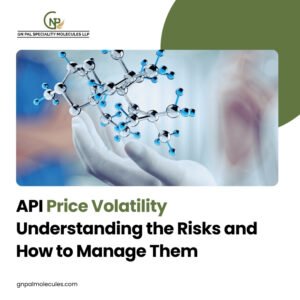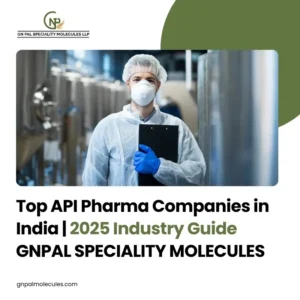
Introduction: Why API Price Volatility Matters
Active Pharmaceutical Ingredients (APIs) are the backbone of global medicine manufacturing. Yet, their prices are far from stable. API price volatility refers to the frequent fluctuations in costs that directly affect pharmaceutical procurement, budgeting, and drug availability.
For pharma buyers and procurement specialists, even small shifts in API pricing can disrupt forecasts, trigger shortages, and escalate costs. Understanding the drivers behind volatility-and knowing how to respond-can mean the difference between maintaining supply continuity or facing costly disruptions.
In this article, we’ll explore:
-
The main drivers of API price volatility
-
How these fluctuations affect pharmaceutical companies
-
Recent trends impacting API pricing
-
Effective strategies companies use to cope with volatility
Main Drivers of API Price Volatility
1. Supply Chain Disruptions & Logistics Challenges
Global supply chains are heavily concentrated in a few regions. China and India produce more than 80% of the world’s APIs, leaving buyers highly dependent on these hubs. This concentration, combined with logistical vulnerabilities, makes API sourcing highly fragile.
Key disruptions include:
-
Rising fuel and energy costs → Higher shipping and production expenses.
-
Labor shortages → Delays in manufacturing and transportation.
-
Port congestion & container shortages → Slower delivery and higher freight rates.
-
Global interdependence → A single bottleneck (e.g., strikes, export bans, natural disasters) can ripple across the entire supply chain.
2. Regulatory Shifts, Tariffs & Export Bans
Governments often intervene in drug supply chains, especially during crises.
-
Export bans (as seen during COVID-19) restricted access to essential drugs, worsening global shortages.
-
Tariffs on pharmaceutical imports increase costs, particularly for the generic drug sector.
-
Geopolitical tensions force countries to prioritize domestic needs, reducing cross-border flow of APIs.
These regulatory shifts don’t just impact availability-they also create price spikes that disproportionately affect lower-income populations dependent on affordable generics.
3. Demand Fluctuations & Seasonal Trends
Demand for APIs fluctuates based on:
-
Pandemics (COVID-19 triggered global shortages).
-
Seasonal diseases (e.g., influenza drives higher demand for antivirals).
-
New therapies (drug launches shift global demand patterns).
Since switching suppliers requires regulatory approval (12–15 months on average), manufacturers can’t quickly adapt. This rigidity worsens shortages when demand surges unexpectedly.
4. Market Competition & Generic Price Decay
Competition plays a dual role:
-
In highly competitive markets, efficiency drives prices down.
-
After patent expiry, generic entry lowers costs, but as some manufacturers exit low-margin markets, prices can rise again due to reduced competition.
This cycle creates ongoing volatility in pricing trends.
5. Cost-Based Factors in API Production
Production costs often dictate API pricing. These include:
-
Raw material prices
-
Manufacturing processes
-
Regulatory compliance & quality testing
-
Overhead costs (logistics, administration, distribution)
While cost-based pricing offers stability in normal conditions, it can fail during volatile markets, where demand shocks and supply bottlenecks drive unexpected surges.
6. Geopolitical & Strategic Risks
Dependence on China and India for APIs has emerged as a global risk.
-
Trade wars, tariffs, and export restrictions increase costs.
-
Strategic government policies (e.g., “local production” mandates in the EU and U.S.) aim to reduce dependence but often add transitional costs.
The result? More unpredictability for buyers who rely on global sourcing.
Why API Price Volatility Matters for Buyers
Pharma procurement teams face multiple challenges due to volatile pricing:
-
Budgeting & Forecasting → Difficult to allocate funds accurately.
-
Timing Purchases → Buying at the wrong time can inflate costs.
-
Risk Mitigation → Reliance on single suppliers increases vulnerability.
A smart sourcing strategy requires real-time data, supplier diversification, and risk planning to navigate this uncertainty.
Recent Trends Shaping API Price Volatility
Several ongoing developments continue to push API prices higher:
-
U.S. Tariffs: 25% tariffs on Chinese APIs and 20% on Indian APIs are already impacting antibiotic and oncology drug costs.
-
Falling Profits in Major API Firms: Companies like Granules India, Glenmark Life Sciences, and Laurus Labs report revenue declines due to oversupply and falling generic drug prices.
-
Logistics Disruptions: Crises like the Red Sea shipping blockages continue to delay deliveries.
-
Environmental Regulations: Stricter waste management rules and sustainability investments increase production costs.
How Companies Can Cope with API Price Volatility
To protect themselves from volatile pricing, companies are adopting proactive strategies:
1. Geographic Diversification
Spreading sourcing across multiple countries reduces exposure to any one region. Many firms are also embracing friendshoring-moving production to politically stable allies.
2. Strategic Supplier Partnerships
Long-term agreements and volume commitments stabilize prices and ensure continuity during demand spikes.
3. Data-Driven Forecasting
Access to real-time trade data and market intelligence helps procurement teams anticipate price trends and negotiate better deals.
4. Dual Qualification & Backup Suppliers
Onboarding multiple API suppliers gives companies flexibility, bargaining power, and protection against disruptions.
5. Using Trusted Marketplaces
Platforms like Pharmaoffer provide access to verified, global suppliers, helping buyers compare prices, check credibility, and avoid sourcing risks.
FAQs on API Price Volatility
Q1. What is API price volatility?
API price volatility refers to unpredictable fluctuations in the costs of active pharmaceutical ingredients due to supply chain, demand, regulatory, and geopolitical factors.
Q2. Why does API pricing matter for pharmaceutical buyers?
Because APIs make up a large portion of drug costs, even small price changes can impact budgets, procurement decisions, and patient access to medicines.
Q3. How do supply chain disruptions affect API pricing?
Delays in logistics, container shortages, or export bans create scarcity, leading to sharp price increases.
Q4. Can cost-based pricing models stabilize API markets?
They offer stability in calm markets but often lag behind real-time changes during crises or sudden demand surges.
Q5. Which countries dominate API production?
China and India account for more than 80% of global API output, making them critical players in the supply chain.
Q6. How can companies reduce exposure to volatility?
By diversifying suppliers, using data-driven sourcing tools, and forming long-term partnerships with trusted manufacturers.
Conclusion: Building Resilience in an Unstable Market
API price volatility is not just a market challenge-it’s a strategic risk. From tariffs and export bans to supply chain bottlenecks and demand surges, pharma companies must prepare for ongoing uncertainty.
By embracing geographic diversification, data-driven intelligence, and strong supplier partnerships, companies can safeguard supply chains, control costs, and maintain patient access to essential medicines.




